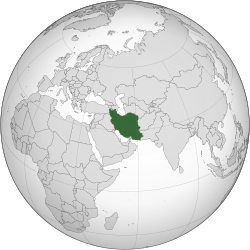Iran in a glance
Iran ;also known as Persia,officially the Islamic Republic of Iran, is a country in western Asia. It is bordered to the northwest by Armenia, the de facto independent Nagorno-karabakh-republic, and Azerbaijan; with Kazakhstan and Russia across the Caspian sea; to the northeast by Turkmenistan; to the east by Afghanistan and Pakistan; to the south by the Persian gulf and the Gulf of Oman; and to the west by Turkey and Iraq. Comprising a land area of 1,648,195 km2 (636,372 sq mi), it is the second-largest nation in the Middle East and the 18th-largest in the world; with 78.4 million inhabitants, Iran is the world's 17th most populous nation. It is the only country that has both a Caspian Sea and an Indian Ocean coastline. Iran has long been of geostrategic importance because of its central location in Eurasia and Western Asia, and its proximity to the Strait of Hormuz.
Iran is home to one of the world's oldest civilizations, beginning with the formation of the Proto-Elamite and Elamite kingdom in 3200–2800 BC. The Iranian Medes unified the area into the first of many empires in 625 BC, after which it became the dominant cultural and political power in the region. Iran reached the pinnacle of its power during the Achaemenid Empire founded by Cyrus the great in 550 BC, which at its greatest extent comprised major portions of the ancient world, stretching from parts of the Balkans (Thrace,Paeonia and Masedonia) in the west, to the Indus valley in the east, making it the largest empire the world had yet seen. The empire collapsed in 330 BC following the conquests of Alexander the great. The Parthian empire emerged from the ashes and was succeeded by the Sasanian dynasty (Neo-Persian Empire) in 224 AD, under which Iran again became one of the leading powers in the world, along with the Roman-Byzantine empire, for a period of more than four centuries.
Rashidun Muslims invaded persia in 633 AD, and conquered it by 651 AD, largely replacing Manichaeism and Zoroastrianism. Iran thereafter played a vital role in the subsequent Islamic golden age, producing many influential scientists, scholars, artists, and thinkers. The emergence in 1501 of the Safavie dynsty, which promoted Twelver Shi’a Islam as the official religion, marked one of the most important turning points in Iranian and Muslim history starting in 1736 under Nader shah, Iran reached its greatest territorial extent since the Sassanid Empire, briefly possessing what was arguably the most powerful empire in the world. In the course of the 19th century, Iran irrevocably lost swaths of its territories in the Caucasus region which made part of the concept of Iran for three centuries, to neighboring Imperial Russia. The Persian constitutional revolution of 1906 established the nation's first parliament, which operated within a constitutional monarchy. Following a coup d’etat instigated by the U.K. and the U.S. in 1953, Iran gradually became very close allies with the U.S. and the rest of the west, remained secular, but grew increasingly autocratic. Growing dissent against foreign influence and political repression culminated in the 1979 revolution, which led to the establishment of an Islamic republic on 1 April 1979.
Tehran is the capital and largest city, serving as the cultural, commercial, and industrial center of the nation. Iran is a major regional and middle power, exerting considerable influence in international energy security and the world economy through its large reserves of fossil fuels, which include the largest natural gas supply in the world and the fourth-largest proven oil reserves .It hosts Asia's 4th-largest number of UNESCO World Heritage Sites.
Iran is a founding member of the UN, ECO, NAM, OIC and OPEC. Its unique political system, based on the1979 constitution, combines elements of a parliamentary democracy with a religious theocracy governed by the country's clergy, wherein the supreme leader wields significant influence. A multicultural nation comprising numerous ethnic and linguistic groups, most inhabitants is Shiites, the Iranian Rial is the currency, and Persian is the official language
Motto:
"استقلال، آزادی، جمهوری اسلامی"
"Esteqlāl, Āzādi, Jomhuri-ye Eslāmi"
"Independence, freedom, the Islamic Republic"
Anthem: مهر خاوران
"The Eastern Sun"
Spoken languages:
- Persian
- Azerbaijani
- Kurdish
- Lurish
- Semnani
- Gilaki
- Mazandarani
- Turkmen
- Arabic
- Baloch
- Talysh
- Georgian
- Armenian
- Neo-Aramaic
Religion Official:
shia Islam
Other recognized religions:
- Sunni Islam
- Christianity
- Judaism
- Zoroastrianism
Demonym:
-Iranian
-Persian
Government: Unitary theocratic republic
Supreme Leader: Ali khamenei
President: Hassan Rouhani
Vice President: Eshaq Jahangiri
-Drives: on the right
Calling code: +98
Internet TLD:
.ir
.ایران
ISO 3166 code: IR





